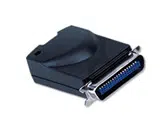Loading ...
Loading ...
Loading ...

CHAPTER 8 LAT NETWORK CONFIGURATION
8-1
CHAPTER 8
LAT NETWORK CONFIGURATION
Brother print servers are equipped with the LAT protocol. If you are
already familiar with configuring DEC servers or compatible terminal
servers in your network, you can use similar procedures to configure a
Brother print server.
LAT Concepts
A Brother printer server will be a node on the network that offers a printing
service to other nodes on the network. A node is simply a device, such as a
host computer, terminal server, or print server. Every node on the network
has a unique name, Brother print servers are pre-configured with the name
"BRO_" followed by the last six digits of the Ethernet address (for
example, "BRO_00C351").
Brother print servers are pre-configured to run on a LAT network without
any additional setup. The configuration can be changed if necessary by
using the NCP, NCL, or ccr facility A LAT on your host computer this
procedure is described in Appendix A of this manual. Note that in most
cases it is not necessary to change the configuration.
To use a Brother print server with a VMS host computer, you will first
need to create a LAT application port on the host. A LAT application port
allows a program to send and receive data over a LAT connection as if it
were communicating with a directly-connected physical port. You will then
need to associate a print queue with this port.
VMS LAT Host Configuration
The configuration process requires that you have system manager
privileges. Before starting the LAT configuration process, you must first
make sure that LAT has been started on your system. If you are currently
using terminal servers on your network, then LAT has probably already
been activated. If LAT is not started, you need to execute the following
command before proceeding:
@SYS$STARTUP:LAT$STARTUP
1. Before creating a print queue, you will need to determine the following:
• The VMS queue name. This can be any unique name. (Do a SHOW
QUEUE command at the VMS prompt to list the existing queues).
Loading ...
Loading ...
Loading ...
